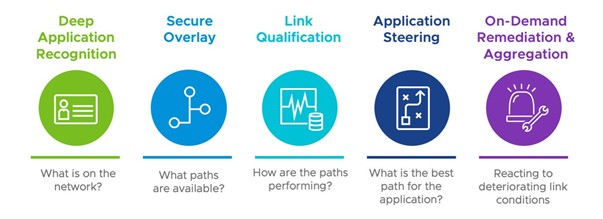Here’s a healthcare nightmare scenario becoming all too common: A physician consults with a remote patient over a videoconference to share the results of an important test. But because the connection is so bad, the screen freezes up, and the patient can’t hear her doctor.
Or, how about this one: A hospital launches a remote monitoring initiative for congestive heart failure, so they can track patients remotely and intervene before they need more invasive and expensive care. But the system can’t get readings from dozens of patients. Is the problem with the monitors? The cloud-based application? Last-mile network issues in a particular neighborhood? IT doesn’t know, and hours turn into days while they try to find out.
You’re probably sensing a theme. Modern telehealth technologies do amazing things, transforming the patient experience and extending state-of-the-art care anywhere. In a post-COVID world, they’re exactly what we need to improve patient outcomes, enhance clinical collaboration, reduce costs, and keep people safe. All these outcomes are now possible—but only if the networks they depend on work.

Around the world, healthcare organizations are modernizing their networks to enable new cloud-based virtual care models. And that’s great news. But as they evaluate new digital connectivity solutions, too many make a crucial mistake: They’re not thinking about network connectivity or security. Of course, security is a foundational requirement for telehealth, but it’s not the only requirement. Performance and reliability matter equally.
Why is it so important to address each of those areas for telehealth? And how can you make sure your digital investments deliver across all of them? Let’s take a closer look.
Delivering care over modern networks
Successful telehealth requires a secure, flexible, and cloud-centric network foundation. After all, the applications needed to provide virtual care—including videoconferencing services, remote monitoring solutions, clinical and business applications—are increasingly delivered from the cloud. But many healthcare networks still work as if applications and the technologies to secure them live in the corporate datacenter. They’re designed to backhaul all traffic through that centralized datacenter, adding latency—which degrades real-time services like videoconferencing—and costs.
The good news is, just as COVID was making the need to digitally transform healthcare especially urgent, modern network technologies emerged that were well-suited to the task. VMware SD-WAN can intelligently route traffic along the best possible path, including over the Internet and directly to the cloud. And today, healthcare organizations can use VMware SASE solutions, which combine SD-WAN with cloud-based security and flexible secure access. It’s the perfect combination for virtual care, arriving at just the right time.
So, with SASE, virtual care should be working perfectly, right? Providers can move full-steam ahead with telehealth initiatives, and patients can expect great virtual experiences every time they connect. Well, not so fast. Here’s the problem: Some organizations rolling out early virtual care solutions had a laser-focus on security—to the exclusion of all other considerations.
Of course, strong security is essential for telehealth. With increasing ransomware attacks, rigid compliance requirements, and an expanding threat surface from new cloud and remote monitoring initiatives, security must top the list for any network overhaul. Especially the flexible cloud security and zero-trust access that SASE delivers. However, security can’t be the only thing on your list. Your telehealth platform can be rock-solid secure from end to end, but if patients and clinicians can’t reliably use it with the performance their applications need, what’s the point?
Prioritizing performance
If you want to avoid your own telehealth horror stories, make sure that any SASE solution you’re considering addresses the performance and reliability side of the equation too. Look for things like:
- Application-aware packet steering: The SD-WAN in your SASE solution should be able to distinguish between the thousands of different applications your users and patients use. It should be able to peek into every packet and deliver the right performance and security for that session, based on policy, as well as real-time conditions over that link.

- Real-time path optimization: In scenarios like video consultations, it’s not enough to recognize problems after the fact. By that point, the patient and physician have already had a bad experience. Your network should be able to detect issues like latency, jitter, and packet loss, and compensate for them as they’re happening. Ideally, even with reduced connectivity or link failure, the session should continue without users realizing there’s a problem.
- Advanced edge intelligence: Many new telehealth technologies sound like they came straight out of Star Trek. But the reality is, many of your users—especially patients, as well as clinical staff working from home—won’t be accessing them over futuristic high-speed circuits. They’ll be connecting over aging last-mile networks and spotty Wi-Fi. You’ll want to maintain fine-grained visibility out at the edge, especially for remote monitoring. You do that with artificial intelligence for IT operations (AIOps), which detects problems and quickly diagnoses the cause. And, by collecting that data, you can understand and continually improve the user experience at the edge.
- Large cloud footprint: With everything moving to cloud, and telehealth connecting more patients and clinicians at home, your users and applications could be literally anywhere. The SD-WAN part of SASE gives you a more flexible cloud-connected network, but it can’t erase the geographic distances between users, cloud applications, and the SASE points of presence connecting them. Ideally, your SASE provider should offer thousands of local gateways. So, no matter where users connect, they always get great performance.
Looking ahead
More and more, the lines between virtual care and just “healthcare” are disappearing. McKinsey & Company estimates up to 20% of all healthcare spending could soon be virtual, and that virtual care could help patients avoid 20% of all emergency room visits and nearly a quarter of doctor visits. That’s a huge cost savings and an enormous benefit to patients. But to get there, we must do telehealth right.
Yes, make sure your network can deliver virtual care securely. But make sure it can deliver consistently great telehealth experiences too.
Learn more
Check out the VMware SASE and VMware SD-WAN web pages to learn more about VMware’s solutions.






